
HMAS Psyche was a Pelorus-class protected cruiser built for the Royal Navy at the end of the 19th century. Initially operating on the North America and West Indies Station, the cruiser was transferred to the Australian Squadron in 1903, and remained there until the Royal Australian Navy (RAN) took over responsibility in 1913. After a stint in New Zealand waters and involvement in the Occupation of German Samoa, Psyche was paid off in 1915.
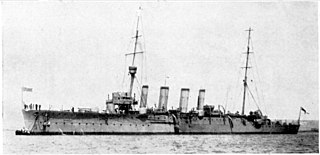
HMAS Melbourne was a Town class light cruiser operated by the Royal Australian Navy (RAN). The ship was laid down by Cammell Laird at Birkenhead in England in 1911, launched in 1912 and commissioned in 1913. At the start of World War I, Melbourne was involved in attempts to locate the German East Asia Squadron, and participated in the capture of German colonies in the Pacific, before being assigned to the North America and West Indies Stations. In 1916, the cruiser joined the Grand Fleet in the North Sea, where she remained for the remainder of the war. Melbourne spent late 1919 and early 1920 in reserve, then was flagship of the Royal Australian Navy from 1920 until 1928, except for a second period in reserve during 1924 and 1925. HMAS Melbourne paid off in the United Kingdom on 23 April 1928, and was scrapped in 1929.

HMS Challenger was a Pearl-class corvette of the Royal Navy launched on 13 February 1858 at the Woolwich Dockyard. She served the flagship of the Australia Station between 1866 and 1870.

HMS Iris was a 26-gun sixth-rate frigate launched on 14 July 1840 from Devonport Dockyard. She spent some time with the West Africa Squadron suppressing the slave trade and later with the East Indies Station was involved in operations in Borneo. Iris was the first flagship of the Australia Station between 1859 and 1861 during which time she participated in the First Taranaki War. In 1864 she was extensively modified to allow her to ferry transatlantic telegraph cable to the cable-laying ship Great Eastern. She was decommissioned and sold off in 1869.

HMS Niger was originally slated to be built as a Sampson designed sloop; however, she was ordered as a First-Class sloop with screw propulsion on 20 February 1845 to be built at Woolwich Dockyard, along the design developed by Oliver Lang and with a hull like the Basilisk designed paddle sloops. Her armament and engine were to be like the Encounter Design building at Pembroke. A second vessel (Florentia) was ordered on 26 March 1846 but after her keel was laid at Pembroke Dockyard, her construction was suspended on 6 October 1846 then cancelled three years later, on 22 May 1849. Niger She conducted important propulsion trials, finally proving the superiority of screw propulsion and served in West Africa, the Crimea, China, the East Indies and Australia. She took part in the New Zealand wars in 1860 and was sold for breaking in 1869.
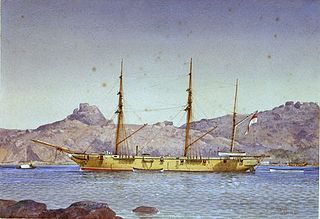
HMS Cordelia was an 11-gun Racer-class sloop of the Royal Navy launched in 1856 and sold in 1870.
HMS Elk was a 482-ton displacement, 16-gun Acorn-class brig-sloop of the Royal Navy launched on 29 September 1847 from the Chatham Dockyard.

HMS Eclipse was a four-gun Cormorant-class first-class gunvessel launched in 1860 from the shipyard of J. Scott Russell & Co., Millwall. She served on the Australia Station, took part in the Second Taranaki War, including contributing men to a naval brigade which attacked the Maori stronghold at Gate Pā. The entire class were never satisfactory as gunvessels, partly due to their excessive draught, and Eclipse was broken up at Sheerness in 1867, only seven years after her launch.
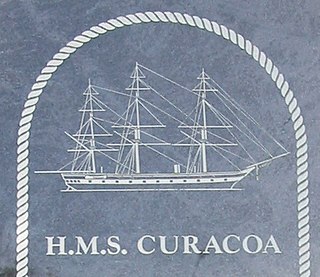
HMS Curacoa was a 31-gun Tribune-class screw frigate launched on 13 April 1854 from Pembroke Dockyard.
Admiral Sir William Loring was a senior officer in the Royal Navy. He was the first Commander-in-Chief of the Australia Station from 26 March 1859 until 10 March 1860. He was also the Rear-Admiral Superintendent of Portsmouth Dockyard between 1870 and 1871.
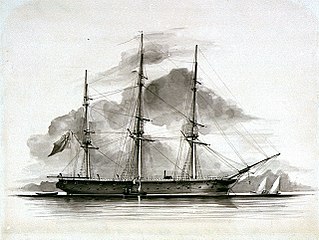
HMS Brisk was a 14-gun wooden-hulled screw sloop designed by the Committee of Reference as part of the 1847 program. She is considered an enlarged Rattler with the design approved in 1847. She was ordered on 25 April 1847 from Woolwich Dockyard as a 10-gun sloop, but the guns were later increased due to the Russian War, to 14 guns by increasing the number of 32-pounder guns. She was launched on 2 June 1851 from Woolwich Dockyard. She served in the Russian War of 1854- 55 and as part of the Southern African anti-slavery patrol, with a final commission on the Australian Station. She was sold in 1870 for use in a pioneer, but unsuccessful, telegraph service.

HMS Salamander was one of the initial steam powered vessels built for the Royal Navy. On 10 January 1831 the First Sea Lord gave orders that four paddle vessels be built to competitive designs. The vessels were to be powered by Maudslay, Son & Field steam engines, carry a schooner rig and mount one or two 10-inch shell guns. Initially classed simply as a steam vessel (SV), she was re-classed as a second-class steam sloop when that categorization was introduced on 31 May 1844. Designed by Joseph Seaton, the Master Shipwright of Sheerness, she was initially slated to be built in Portsmouth, and was changed to Sheerness Dockyard. She was launched and completed in 1832, took part in the Second Anglo-Burmese War and was broken up in 1883.

HMS Falcon was a 17-gun Royal Navy Cruizer-class sloop launched in 1854. She served in the Baltic Sea during the Crimean War and then in North America, West Africa and Australia. She was sold for breaking in 1869.

HMS Hecate was a 4-gun Hydra-class paddle sloop launched on 30 March 1839 from the Chatham Dockyard.
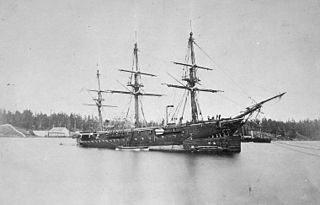
HMS Charybdis was a 21-gun Royal Navy Pearl-class corvette launched on 1 July 1859 at Chatham Dockyard.
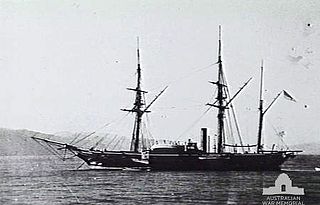
HMS Virago was a Royal Navy Driver-class wooden paddle sloop launched on 25 July 1842 from Chatham Dockyard.

HMS Mohawk was an Archer-class torpedo cruiser of the Royal Navy, built by J. & G. Thompson at Glasgow and launched on 6 February 1886.

HMS Myrmidon was a Cormorant-class gunvessel of the Royal Navy, built at Chatham Dockyard and launched in 1867. She served on the North America and West Indies Station and surveyed parts of the Australian coast before being sold at Hong Kong in 1889.

HMS Diamond was an Amethyst-class corvette in service 1874–89.

HMS Barracouta was the last paddle sloop built for the Royal Navy. She was built at Pembroke Dockyard and launched in 1851. She served in the Pacific theatre of the Crimean War, in the Second Opium War and in the Anglo-Ashanti wars. She paid off for the last time in 1877 and was broken up in 1881.


















